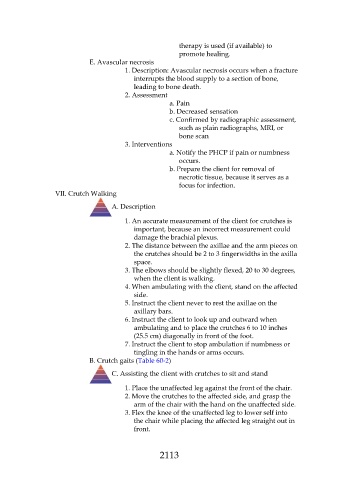Page 2113 - Saunders Comprehensive Review For NCLEX-RN
P. 2113
therapy is used (if available) to
promote healing.
E. Avascular necrosis
1. Description: Avascular necrosis occurs when a fracture
interrupts the blood supply to a section of bone,
leading to bone death.
2. Assessment
a. Pain
b. Decreased sensation
c. Confirmed by radiographic assessment,
such as plain radiographs, MRI, or
bone scan
3. Interventions
a. Notify the PHCP if pain or numbness
occurs.
b. Prepare the client for removal of
necrotic tissue, because it serves as a
focus for infection.
VII. Crutch Walking
A. Description
1. An accurate measurement of the client for crutches is
important, because an incorrect measurement could
damage the brachial plexus.
2. The distance between the axillae and the arm pieces on
the crutches should be 2 to 3 fingerwidths in the axilla
space.
3. The elbows should be slightly flexed, 20 to 30 degrees,
when the client is walking.
4. When ambulating with the client, stand on the affected
side.
5. Instruct the client never to rest the axillae on the
axillary bars.
6. Instruct the client to look up and outward when
ambulating and to place the crutches 6 to 10 inches
(25.5 cm) diagonally in front of the foot.
7. Instruct the client to stop ambulation if numbness or
tingling in the hands or arms occurs.
B. Crutch gaits (Table 60-2)
C. Assisting the client with crutches to sit and stand
1. Place the unaffected leg against the front of the chair.
2. Move the crutches to the affected side, and grasp the
arm of the chair with the hand on the unaffected side.
3. Flex the knee of the unaffected leg to lower self into
the chair while placing the affected leg straight out in
front.
2113

